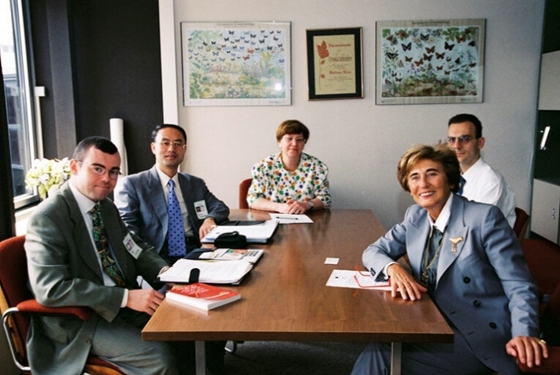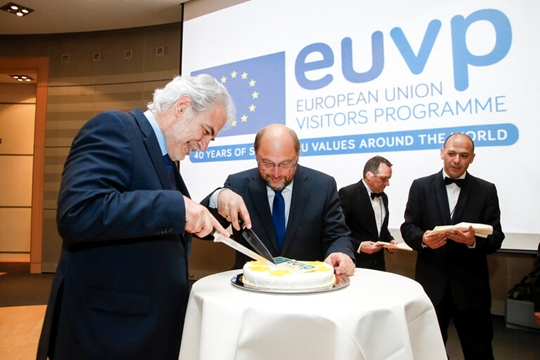Celebrating over 50 years of the European Union Visitors Programme

The European Union Visitors Programme (EUVP) hosts hundreds of visitors every year from all over the world as the EU’s flagship public diplomacy initiative. The EUVP Participants and Alumni provide their EU Colleagues with valuable, unfiltered information, expertise and influence. But where did it all start?
For over five decades, the EUVP has served as a bridge between nations, connecting global leaders to the heart of Europe. What began as a single month-long study visit programme in 1974, has grown into a dynamic platform for fostering international dialogue, sharing knowledge, and building mutual understanding. In this article, we explore how the EUVP has evolved over the decades to shape global cooperation and deepen diplomatic ties across the world.
1970s: Pioneering global engagement
The EUVP’s journey began in 1974 with a bold idea: to enhance relations between Europe and the United States. The inaugural study visit welcomed five visitors from the U.S., offering them a firsthand look at how the European Communities (the precursor to the European Union) functioned. Back then, the programme was known as the European Community’s Visitors Programme (ECVP). Its aim was to foster better understanding and strengthen diplomatic relations. By 1977, the programme’s success encouraged its expansion to include participants from Canada and Latin America, setting the stage for a global outreach initiative that would continue to grow.
1980s: Expanding horizons
The 1980s marked a time of rapid growth for the programme. As the global landscape shifted, the EUVP began welcoming participants from new regions, including Australia, New Zealand, and Japan—nations with significant economic and political ties to Europe. The programme soon became an essential tool for strengthening these connections. It also played a vital role as Europe underwent major political changes following the Cold War, becoming a vital channel for fostering dialogue with new international players. By the end of the decade, it was clear that the EUVP had evolved from a simple diplomatic initiative into a highly advantageous foreign policy instrument.
1990s: Embracing global inclusivity
As the 1990s unfolded, the EUVP reflected the European Union’s growing presence on the global stage. New participants from ASEAN countries, China, South Korea, and Türkiye were welcomed, underscoring t he EU's expanding diplomatic influence. During this period, the programme officially transitioned from the European Community Visitors Programme (ECVP) to the European Union Visitors Programme (EUVP). With an increasing number of participants, the programme saw its capacity rise, welcoming nearly 90 leaders annually and bringing diverse global perspectives to the table.
he EU's expanding diplomatic influence. During this period, the programme officially transitioned from the European Community Visitors Programme (ECVP) to the European Union Visitors Programme (EUVP). With an increasing number of participants, the programme saw its capacity rise, welcoming nearly 90 leaders annually and bringing diverse global perspectives to the table.
In the picture: MEP Ursula SCHLEICHER with guests of the European Union
(High Level) Visitors Programme (EUVP) (Source: European Parliament Multimedia Centre)
2000s: Adapting to EU enlargement
The early 2000s marked a transformative era for Europe, with the enlargement of the EU to the East. The EUVP played a key role in supporting the new member states as they navigated the complex integration process. Between 1999 and 2001, the programme welcomed a record-breaking 210 participants, many of whom came from soon-to-be EU member states. It helped prepare these leaders for their future roles within the EU, familiarizing them with EU institutions and policies. This period marked a pivotal moment for both the EU and the programme as a whole.
2010s: New challenges breed innovation

In the 2010s, the EUVP was faced with new challenges. Despite budget constraints and an increasingly complex global political landscape, the programme continued to expand, welcoming 155 participants in 2018. The decade also marked the 40th anniversary of the EUVP, a milestone that underscored its long-standing success in fostering international connections and dialogue.
In the picture: EUVP -The President of the European Parliament, Mr Martin SCHULZ, celebrates the EUVP 40th anniversary in 2015. (Source: European Parliament Multimedia Centre)
2020s: Thriving in a new era of virtual engagement
The COVID-19 pandemic brought unprecedented challenges to global diplomacy, disrupting traditional travel. The EUVP showcased its resilience by quickly transitioning to virtual formats, ensuring the programme’s continued relevance in times of crisis. Online sessions allowed participants to engage with the EU from the safety of their homes, reinforcing the programme’s commitment to fostering  international connections, no matter the obstacles. In 2020, the EUVP hosted over 200 online sessions, introducing virtual discussions, alumni webinars, and EU policy debates that connected leaders around the world. The programme’s ability to adapt to a digital-first world demonstrated its enduring value and ensured that global leaders continued to engage with the EU’s vital work.
international connections, no matter the obstacles. In 2020, the EUVP hosted over 200 online sessions, introducing virtual discussions, alumni webinars, and EU policy debates that connected leaders around the world. The programme’s ability to adapt to a digital-first world demonstrated its enduring value and ensured that global leaders continued to engage with the EU’s vital work.
In the picture: The COVID-19 pandemic moved the EUVP to an era of virtual meetings
A legacy of connection, cooperation, and innovation
As the EUVP celebrates over 50 years of success, it remains a testament to the power of dialogue and international collaboration. From its modest beginnings in 1974 to its current status as a global platform for public diplomacy, the EUVP continues to strengthen bonds, foster understanding, and promote cooperation across the world. It brings tremendous benefits to the EU and its 27 Member States. With each new decade, the programme has adapted to a changing world, ensuring that it remains as relevant today as it was when it first started. Here's to another 50 years of connecting the world with the heart of Europe!
Article written by:
Alessia Cavallaro, European Union Visitors Programme Unit, European Parliament
Kaarlo Kallio, Foreign Policy Instruments, European Commission
